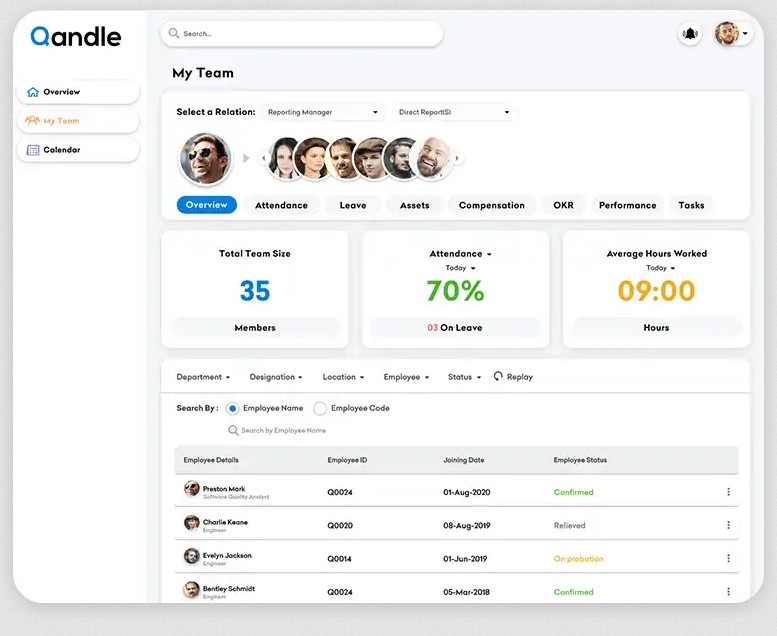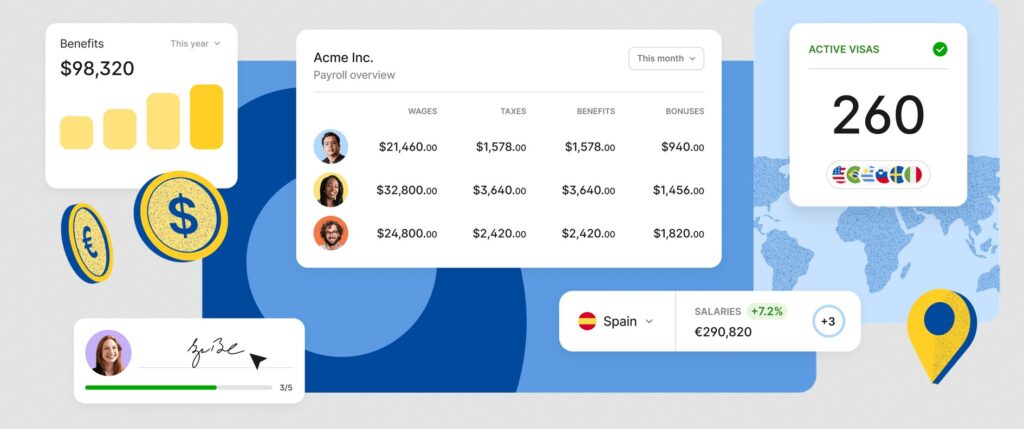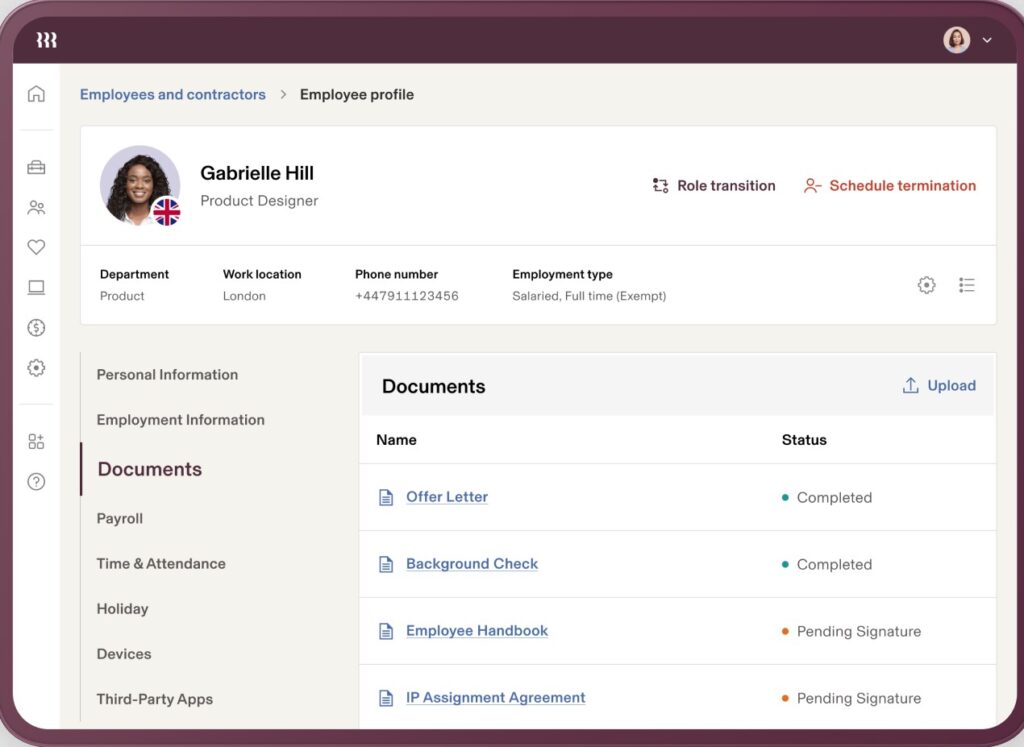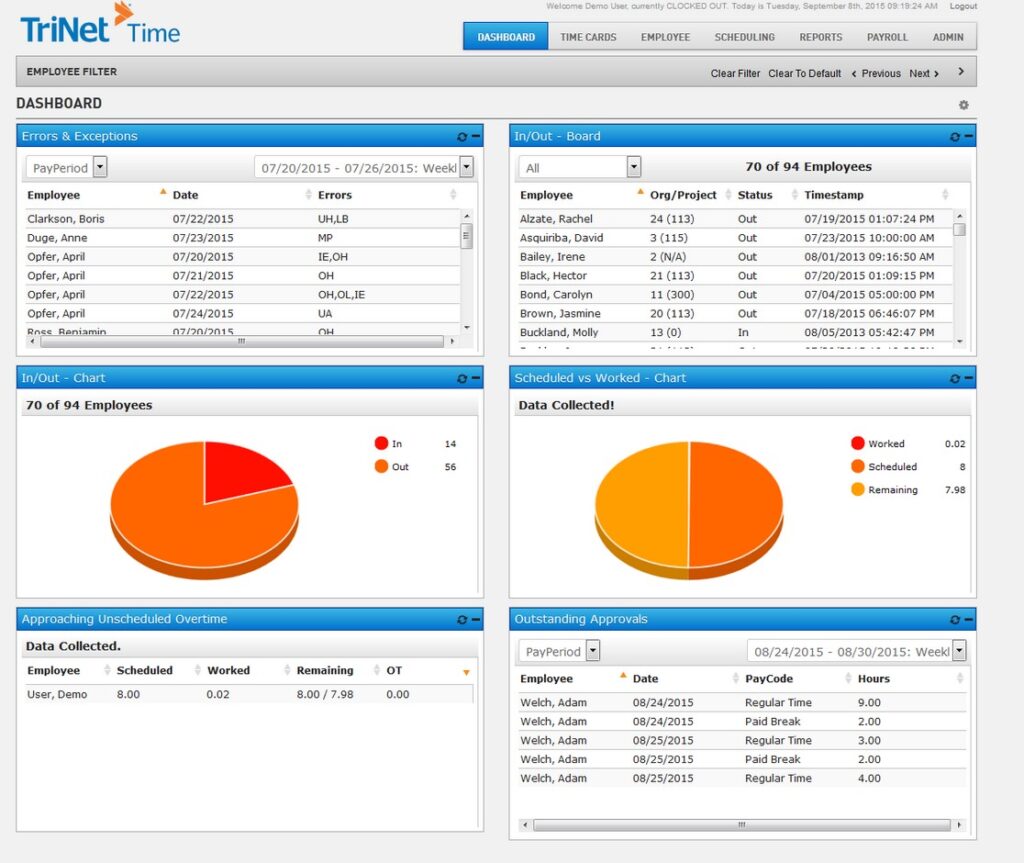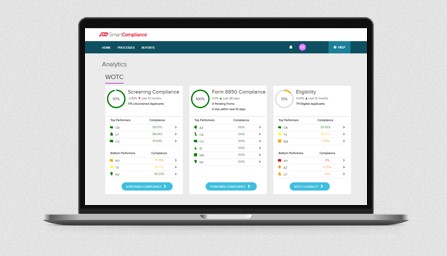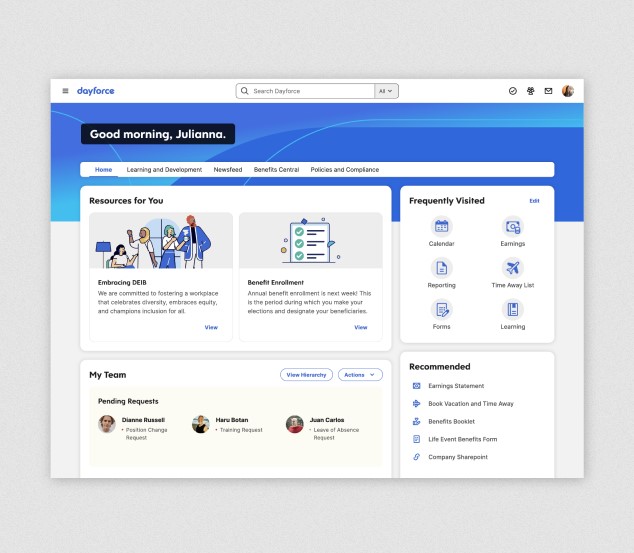In today’s remote and hybrid working environments, it’s hard to keep track of employee’s working hours to provide a fair reward and recognition for their efforts. Also, you want to ensure that your operations meet the local HR business regulations and compliance laws. Furthermore, you must communicate the regulations to the employees and document all the policies and processes related to HR operations.
We have identified the best tools that can work across most business use cases to save time and effort for you. Our list includes:
- Qandle An HR compliance software that tracks and monitors statutory compliances in your organization.
- Deel A payroll and compliance tool that works well for organizations of all sizes.
- Rippling A workforce management system that combines HR, IT, and finance modules on a unified data platform.
- TriNet An HR compliance management software that provides a single place to manage all your HR needs.
- ADP SmartCompliance An all-in-one payroll and HR compliance tool that aggregates data, automates tasks, and helps comply with regulations.
- Dayforce A global HR compliance management software encompassing HR, payroll, benefits, workforce management, taxation, and compliance.
Managing all these aspects manually is hard, as it requires time and effort. Moreover, there’s always a possibility for errors. You need automated solutions to address these concerns, help your organization manage employee benefits, and meet compliance.
In this guide, we will talk about HR compliance software, and how it can benefit your organization. We will also review the best tools to help you decide the best fit for your organization’s requirements.
What is HR Compliance Software?
An HR compliance software is a platform that meets the ever-changing HR regulations while meeting the growing complexity of your employee benefits. Broadly speaking, HR compliance software can include the following aspects:
- Monitor and comply with local and global HR regulations.
- Provide templates for documenting HR processes and workflows.
- Manage time and attendance.
- Classify and manage pertinent documents.
- Offer the tools for communication.
- Compute appropriate benefits for each employee.
- Include a comprehensive leave management system.
- Securely store employee data.
- Ease onboarding.
Not all HR compliance software will have the above features, but select the one that covers the features you need.
Before jumping into the best HR compliance software, let’s see why you need this tool in the first place.
Benefits of HR Compliance Software
HR compliance software offers multiple benefits for organizations of all sizes. Here’s a breakdown of the important ones.
Reduced Risk of Non-Compliance
Keeping track of HR regulations across different jurisdictions can be challenging for your HR team. At the same time, non-compliance increases the possibility of heavy fines and penalties. An HR compliance software will ensure your organization meets the legal requirements. Moreover, it can streamline compliance data and centralize record-keeping to ease auditing and manage evidence.
Enhanced Efficiency and Productivity
With this software, you can automate many HR tasks like tracking training progress, managing leave requests, calculating working hours, and more. Some tools even come with self-service portals where employees can update their information, request time off, and get information about HR policies. Such automation saves time and effort for the HR team without compromising on service quality.
Improved Decision-Making
HR software provides the required data and insights to make informed decisions about talent management and employee benefits. Many tools can even generate insightful reports that can throw more light on specific aspects. Accordingly, the management can formulate appropriate policies.
Increased Employee Experience
Employees prefer transparency and accessibility to information, and HR compliance can provide them. Also, these tools can improve communication between employees and the HR team, leading to better employee experience and motivation.
Ensures Scalability and Adaptability
The dynamic business environment requires adaptive and scalable HR practices that meet these changing requirements. With HR compliance software, many of these changes can be automatic, especially those related to changing compliance requirements. Also, these platforms can scale well to meet your growth, as they work well across multiple regulations and jurisdictions.
Streamlined Documentation
Documentation is an essential part of HR activities and many regulations even mandate the maintenance of documents in specified formats. However, this documentation process is stressful and time-consuming. Many HR software come with templates that can ease this process.
Robust Data Security
Most HR compliance software comes with security features to protect sensitive employee data. This ensures that confidential information like personal details, payroll data, and performance reviews are protected against unauthorized access or breaches. Such measures help organizations to build trust with their employees and stakeholders.
Due to these advantages, many organizations prefer using HR compliance software to meet their obligations.
Our Methodology
Here are the criteria against which we evaluated different tools:
- Compliance with a wide range of HR regulations.
- Seamless integration with existing systems.
- Support for documentation, along with templates.
- Good technical and customer support.
Best HR Compliance Software
Next, let’s review the above tools to identify the best fit for your needs.
1. Qandle
Qandle is an HR compliance platform that can help meet the ever-changing statutory requirements. It auto-updates as regulations change to ensure you’re always compliant. Its intuitive dashboards and reports also add to its appeal. More importantly, I found that it integrates with all tech stacks, making it flexible for all organizations.
Source: Qandle
Qandle’s salient features are described below.
Unified Visibility
Qandle stores all the relevant data in a centralized location, providing unified views of your employee details like payrolls, working hours, leave applications, and more. You can use this information to analyze patterns and insights for improving your process efficiency. It can also manage all the important data needed to file TDS returns.
Extensive Reports
Another important feature of this tool is its extensive reports. You can access all the statutory reports and their templates to save time. Moreover, you can plug your organization’s data into the templates for quick compliance with HR regulations. These reports can be used from your mobile devices as well.
Automatic Calculations and Compliance
Qandle automatically calculates the Labor Welfare Fund and other deductions based on the employee’s location, and the pertinent local laws of that place. It also comes with built-in tax regulations for different states for TDS calculations. Furthermore, it supports autoconfigured ESI computation based on the salary structure.
Overall, Qandle is a comprehensive HR compliance platform that goes beyond compliance and eases other HR activities.
Pros:
- Complete payroll management.
- Support for employee onboarding.
- Easy to configure.
- Intuitive design.
Cons:
- No sync with biometric machines.
- Slightly slow at times.
2. Deel
Deel is a payroll and compliance platform that works best for global teams. With this tool, you can process payroll, meet HR compliance regulations, generate reports, and more. You can also process and make payments across different currencies.
Source: Deel
Below are Deel’s HR compliance features.
Manage the Global Worker Lifecycle
Deel’s HRIS module is designed for a global team, as it can support workers across 150+ countries. This comprehensive platform can automate many HR admin tasks to save time and effort. Moreover, it can manage the entire worker lifecycle, from onboarding to deprovisioning.
Data Consolidation
With Deel, I noted that you can consolidate all data about your employees, contractors, freelancers, and others, regardless of their roles and locations. As a result, you eliminate data silos and can get comprehensive insights into employee performance, efficiency, costs, and other aspects for informed decision-making.
Continuous Compliance
Deel helps you stay on top of changes in regulatory compliance and recommends actions to meet them. It has many features for managing employee benefits and deductions, filing local taxes, creating contracts and documents, and other aspects required to meet HR regulations.
With such streamlined features, Deel is well-suited for organizations with a global workforce, as it helps comply with the regulations of multiple regions and countries.
Pros:
- Works well for global employees.
- Intuitive user interface.
- Responsive customer support.
- Streamlined HR processes.
Cons:
- Delays in salary deposits.
- Confusing payment structure.
3. Rippling
Rippling is a comprehensive workforce management system that combines HR, finance, and IT to provide extensive control and visibility. It can automate many processes and help you make data-driven decisions to improve efficiency.
Source: Rippling
Let’s now take a deeper look into Rippling’s HR module.
Global Payroll
With Rippling, you can hire and pay a global workforce within minutes. It helps onboard employees and contractors easily and provides the required devices and training to help them get started. I observed that the website claims that your onboarding takes only 90 seconds. Moreover, you can pay employees in their local currency without waiting for currency conversions.
Automate Compliance
Rippling helps comply with local laws across the world. It even automatically calculates and files payroll taxes, regardless of your employee’s location. Moreover, Rippling has a robust Anti-money Laundering (AML) program to detect and report suspicious activities and ensure compliance with any country’s AML guidelines.
End-to-end Operations
Rippling handles all your HR activities, from managing headcount, recruiting, training, and managing benefits, to documentation. At every step, it ensures that your actions are compliant with the local laws to avoid fines and penalties. You can even use this tool to survey employees and analyze their feedback.
Rippling is a comprehensive tool for managing all your HR activities, and you can extend it to your finance and IT operations when required.
Pros:
- Excellent onboarding.
- Performance management.
- Pre-built reports.
- Employee self-service options.
Cons:
- The approval process can be more streamlined.
- State tax account setup can be complex.
4. TriNet
TriNet helps you stay on top of changing HR regulations and automatically comply with them. It integrates compliance into every HR process like compliance, outsourcing, and benefit computation. All this means the risks due to non-compliance decrease greatly.
Source: TriNet
Let’s take a detailed look at TriNet’s features.
Intuitive Dashboard
A highlight of TriNet is its intuitive dashboard. This intuitive pane contains all the key metrics you need to understand the state of your HR activities. The data is tracked in real time and can be customized based on the employee’s role. Managers and supervisors can have access to advanced insights for making better decisions.
Manages Regulatory Compliance
You can use TriNet to manage regulatory compliance with many standards like ACA, COBRA, EEOC, and I-9. More importantly, you can understand different states and even countries’ regulatory requirements and tailor your processes accordingly. Its Compliance Assistant sets custom deadline requirements based on your compliance requirements to ensure you get all of them.
Eases HR Functions
TriNet eases every HR function. During onboarding, you can collect the new hire’s tax information and complete Form I-9 required to onboard new employees. Similarly, you can track overtime hours based on the state and local requirements. Also, you can keep the collected documents, including W-4s, in a secure location for easy access.
Due to these features, I realized that TriNet can be a handy tool to streamline your HR operations while ensuring compliance with pertinent laws.
Pros:
- Multi-state payroll processing.
- Easy to administer benefits.
- Robust reporting.
- Works well for local and global teams.
Cons:
- Customer support can be quicker.
- It can be expensive for small businesses.
5. ADP SmartCompliance
ADP SmartCompliance is an intelligent solution for HR compliance, as it handles everything from ACA to employment tax. This tool helps you stay one step ahead of your payroll compliance obligations.
Source: ADP
Below are ADP’s compliance features.
Payroll Tax Compliance
Payroll tax requirements are challenging, especially if you have a combination of employees, contractors, and freelancers. ADP SmartCompliance eases this process with its proactive regulatory monitoring for changes to federal, state, and local taxes. Moreover, it simplifies tax processing and offers a streamlined solution for your organization.
Employment Verification
With ADP, you can simplify the verification requests for loans, mortgages, credit card applications, and more. It automates the employment status and income verification processes without compromising employee privacy. More importantly, it saves time and effort for HR professionals.
Business Tax Credits
Your business can earn tax credits for certain operations. For example, I learned that you can get an R&D tax credit for certain domestic expenses. However, getting this federal credit requires extensive documentation, and ADP can handle it. More importantly, its experts can maximize eligible credits for your organization.
Additionally, ADP SmartCompliance helps with ACA compliance, wage garnishment regulations, unemployment claims, and more. With such robust features, this tool can manage all your HR compliance requirements.
Pros:
- Easy to upload documents.
- Works well for different jurisdictions.
- Multi-state and multi-user payroll tax processing.
- Employment verification.
Cons:
- Tax code identification can be easier.
- Better customer support can help.
6. Dayforce
Dayforce is an end-to-end HR Compliance Management (HCM) platform that offers HR, payroll, workforce management, and more through a single interface. This tool automates many processes and reduces the errors and risks associated with non-compliance. Specifically, it ensures employee data privacy and security to comply with many regulations.
Source: Dayforce
Below are Dayforce’s HR compliance features.
Payroll Processing
Dayforce offers a configurable rules-based payroll engine to manage jurisdictional and industry-specific regulations. Also, it maintains your data and performs continuous calculations to ensure that your payroll meets the local HR laws. You can also proactively audit payroll processing activities for compliance.
Wide Compliance
I determined that Dayforce is a good choice for complying with regulations like SOC II, NIST 800-171, ISO, PIPEDA, and more. Also, it complies with breach notification laws and other data security standards to provide comprehensive protection for sensitive data.
Reports and Insights
With Dayforce, you gain comprehensive insights into the trends and patterns of employee payroll processing and your HR activities. Its well-designed dashboards offer an intuitive user experience, while its centralized insights support data-driven decision-making.
With such features, Dayforce can help you build compliant HR practices that work well across all jurisdictions.
Pros:
- Supports complex payroll rules.
- Easy to add timesheets and approved leaves.
- Excellent customer support.
- Internal auditing processes.
Cons:
- No on-premise deployment.
- Limited reporting customizations.
Thus, these are the best HR compliance software that can be extended to all jurisdictions and are backed by excellent customer support. If you’re looking for specific features or compliance, check if your selected software can meet them.
Bottom Line
HR processes have evolved to meet the growing complexity of work environments. As we transition to a remote and hybrid work environment, there’s a greater need for your HR processes to meet the local laws of different jurisdictions. Also, processing the payroll of a global workforce is challenging, as the calculations can vary depending on where an employee is located. Moreover, data security and privacy can further add to the HR team’s burden.
HR compliance software can address these challenges and make your HR personnel more efficient and productive. In this guide, we explored the possible features of this software and the benefits it can offer your organization. We also reviewed six tools that are compatible with most existing tech stacks and have the capabilities to manage a global workforce. You can use this information to get started with compliant HR activities that translate to cost savings.

